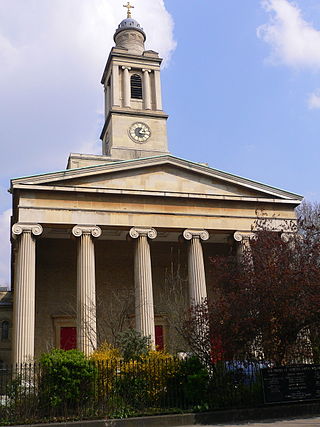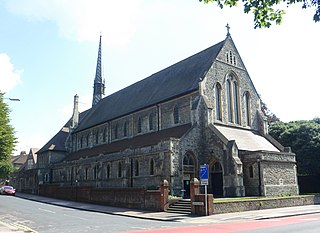
Bethnal Green is an area in the East End of London 3 miles (4.8 km) northeast of Charing Cross. The area emerged from the small settlement which developed around the Green, much of which survives today as Bethnal Green Gardens, beside Cambridge Heath Road. By the 16th century the term applied to a wider rural area, the Hamlet of Bethnal Green, which subsequently became a Parish, then a Metropolitan Borough before merging with neighbouring areas to become the north-western part of the new London Borough of Tower Hamlets.

Bethnal Green was a civil parish and a metropolitan borough in the East End of London, England.

St Andrew Undershaft is a Church of England church in the City of London, the historic nucleus and modern financial centre of London. It is located on St Mary Axe, within the Aldgate ward, and is a rare example of a City church that survived both the Great Fire of London and the Blitz.

All Saints, Margaret Street, is a Grade I listed Anglo-Catholic church in London. The church was designed by the architect William Butterfield and built between 1850 and 1859. It has been hailed as Butterfield's masterpiece and a pioneering building of the High Victorian Gothic style that would characterize British architecture from around 1850 to 1870.

Sir Arthur William Blomfield was an English architect. He became president of the Architectural Association in 1861; a Fellow of the Royal Institute of British Architects in 1867 and vice-president of the RIBA in 1886. He was educated at Trinity College, Cambridge, where he studied Architecture.

St Paul's Church, Shadwell, is a Grade II* listed Church of England church, located between The Highway and Shadwell Basin, on the edge of Wapping, in the East End of London, England. The church has had varying fortunes over many centuries, and is now very active, having been supported recently by Holy Trinity Brompton Church.

St Martin's Church in Bladon near Woodstock, Oxfordshire, England, is the Church of England parish church of Bladon-with-Woodstock. It is also the mother church of St Mary Magdalene at Woodstock, which was originally a chapel of ease. It is best known for the graves of the Spencer-Churchill family, including Sir Winston Churchill, in its churchyard.

St George's Cathedral is an Antiochian Orthodox church in Albany Street, St Pancras, in the London Borough of Camden. Built to the designs of James Pennethorne, it was consecrated as an Anglican place of worship called Christ Church in 1837. It became an Orthodox cathedral in 1989.

Oxford House in Bethnal Green, East London, was established in September 1884 as one of the first "settlements" by Oxford University as a High-Anglican Church of England counterpart to Toynbee Hall, established around the same time at Whitechapel.

St. Peter's Church, Eaton Square, is a Church of England parish church at the east end of Eaton Square, Belgravia, London. It is a neoclassical building designed by the architect Henry Hakewill with a hexastyle portico with Ionic columns and a clock tower. On 19 October 1991 The Times newspaper wrote "St Peter’s must now rank as one of the most beautiful churches in London". It is a Grade II* listed building.

William Railton (1800–77) was an English architect, best known as the designer of Nelson's Column. He was based in London, with offices at 12 Regent Street for much of his career.

Henry Mackenzie was Bishop of Nottingham from 1870 until 1877. He became the first suffragan bishop in the Church of England since 1608.

St John the Evangelist's Church is an Anglican church in the Preston Village area of Brighton, in the English city of Brighton and Hove. The Grade II listed building, designed by Sir Arthur Blomfield, was started in 1901 but did not take its present form for another quarter of a century. In the meantime, the nearby parish church of Preston was severely damaged by fire, and the new church was granted the parish church status which it still retains.

St John's Notting Hill is a Victorian Anglican church built in 1845 in Lansdowne Crescent, Notting Hill, London, designed by the architects John Hargrave Stevens (1805/6–1857) and George Alexander (1810–1885), and built in the Victorian Gothic style. Dedicated to St John the Evangelist, the church was originally built as the centrepiece of the Ladbroke Estate, a mid nineteenth century housing development designed to attract upper- and upper middle-class residents to what was then a largely rural neighbourhood in the western suburbs of London.

Columbia Road Flower Market is a street market in Bethnal Green in London, England. Columbia Road is a road of Victorian shops situated off Hackney Road in the London Borough of Tower Hamlets. The market is open on Sundays only.

The Barn Church, Kew, formally known as St Philip and All Saints, is the first barn church to be consecrated in England. The building, which is not listed, is on the corner of Atwood Avenue and Marksbury Avenue, in an area previously known as North Sheen and now in Kew, in the London Borough of Richmond upon Thames. It was constructed in 1929 from a 17th century barn from Oxted in Surrey. The west end was converted in 2002 into a large parish room with a gallery above looking down the length of the building. The sanctuary was refurbished and remodelled in 1998.

St Barnabas Bethnal Green is a late 19th-century church in Bow in London, England. It is an Anglican church in the Diocese of London. The church is at the junction of Roman Road and Grove Road in the Bow West ward of London Borough of Tower Hamlets.

St Matthew's, Bethnal Green, is an 18th-century church in Bethnal Green, London, England. It is an Anglican church in the Diocese of London.

St Peter's Church, is an early Victorian Church of England church in Arkley, in the London Borough of Barnet. It is a grade II listed building.

The Church of St Simon is a Church of England parish church in Shepherd's Bush, London. It was built circa 1879 - 1886, designed by architect Sir Arthur Blomfield in the Gothic Revival style with a tower. The church is located on the south side of Shepherd's Bush Green on Rockley Road.





















